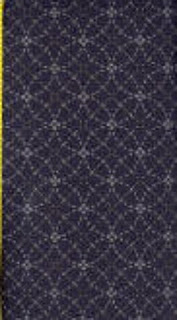Sashiko(pronounced: Sa-Shi-Koe) is a traditional Japanese needlework technique. The technique can be traced back to the Edo period (1603-1868). The workers could not afford expensive milled fabric so out of necessity they needed to extend the life of their worn clothing. By stitching layers of cloth together they were also able to wear summer weight fabric throughout the winters. As the cost of fabric became less expensive the sashiko style of stitching became more decorative.
Traditionally, Sashiko is most commonly seen on indigo dyed cotton. Today we can purchase pre-printed fabric ready to stitch. If you wish to transfer a design onto your own fabric choose an even weave that is tightly woven. Prewash before stitching. The traditional sashiko designs are inspired by nature and use ‘negative’ space as a design feature. The thread is 100% white cotton with a high twist. Variegated sashiko threads can also be purchased. You can also use Perle cotton or embroidery floss. The traditional sashiko needles are about 2 inches long and uniform in width, the eye is very small. Use a needle that you are comfortable with and that you can thread easily.

Sashiko stitching does not require an embroidery hoop nor do you knot the beginning or end of fabric. While the word sashiko means ‘little stabs” the stitch is more ‘rocking’ than ‘stabbing’. Stitching is one- directional and the designs follow a set order of stitching. Vertical and horizontal lines are done first, followed by diagonal lines, and then curved lines. Insert the needle into the fabric without pulling the thread through. Continue inserting the needle into the fabric as you do with running stitch without pulling the fabric through. When you have multiple stitches on the needle ease the thread through the fabric. Take care not to pucker the fabric. If your pattern has a change of direction leave a small loop at the change point on the wrong side of fabric. This will prevent puckering.

Sashiko is an easy stitching project for a beginner with lots of practical uses for the finished work. For the more adventurous the designs also lend themselves to beading. If you haven’t already tried sashiko try it next time you are considering a project.

No comments:
Post a Comment